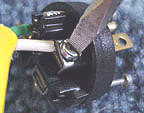This morning I went into the shop to begin work on a new project. The air was cold and crisp, the temperature around 26 degrees, and the sun was shining brightly. I was inspired this morning to work on some cabinet doors that I had to build for a kitchen remodel. I soon realized that instead of working on the doors, I would be working on my circular saw because it would not run.
This type of thing is quite common in my shop since most of the tools in there are older than my children. This particular saw is a Porter Cable brand and has worked very well for me for several years. I actually got the saw when my youngest son worked with a salvage company here in town. His job was to strip off all the usable parts from trucks for salvage. One of the perks of his job was anything that was left in the vehicle by the previous owner was his for the taking.
My first instinct when one of my tools stops working is to try another outlet to make sure I have a reliable power source. This morning I had plugged the saw into an extension cord, so I first tried the saw directly in a known good outlet in the shop. The saw still did not work. I got out my screwdriver and removed the newly installed plug on the end of the cord.
There the problem was quite obvious. One of the wires in the plug had pulled loose from the screw that secures it to the blade prong. I replaced the wire, tightened the screw, checked the other wire, put everything back together, and voila, the saw worked as good as new.
I then remembered that I had last used the saw on a job building a pump house. During the job, the cord had become entangled under some lumber and caused me to pull the saw cord a little too hard. All this rambling brings to mind six points that I want to give you when one of your tools stops working.
Rule #1. Before discarding a tool that has stopped working, check to make sure that your power source is reliable. Many times an extension cord can be the culprit. Before you plug the tool into an outlet, check that outlet with another tool first to ensure there is power there. Occassionaly a breaker can be tripped in the breaker box causing you to lose power to that circuit.
Rule #2. Before you place your hands around a blade on a tool that is not working, make sure you unplug the tool. A wire could be loose inside that could make contact at the wrong time causing the tool to start while your hands are in the wrong place. Bad News!
Rule #3. Before you work on any electrical device, unplug it or switch off the breaker if the tool can not be unplugged. Electricity is deadly.
Rule #4. Always check the easiest and cheapest things first. If the tool suddenly stops working, check the wires in the cord first. Then work your way into the tool next.
Rule #5. When you remove parts from the tool, put them in a container so you don’t lose any parts. There’s nothing worse than repairing a tool that you still can’t use because you lost some of the parts.
Rule #6. If you can’t put something back together that you took apart, don’t attempt the repair yourself. Let a professional do the job for you.
Well my saw is fixed and now I’m ready to get to work on those doors. So until next time, work hard, stay safe, and as always, thanks for stopping by.


